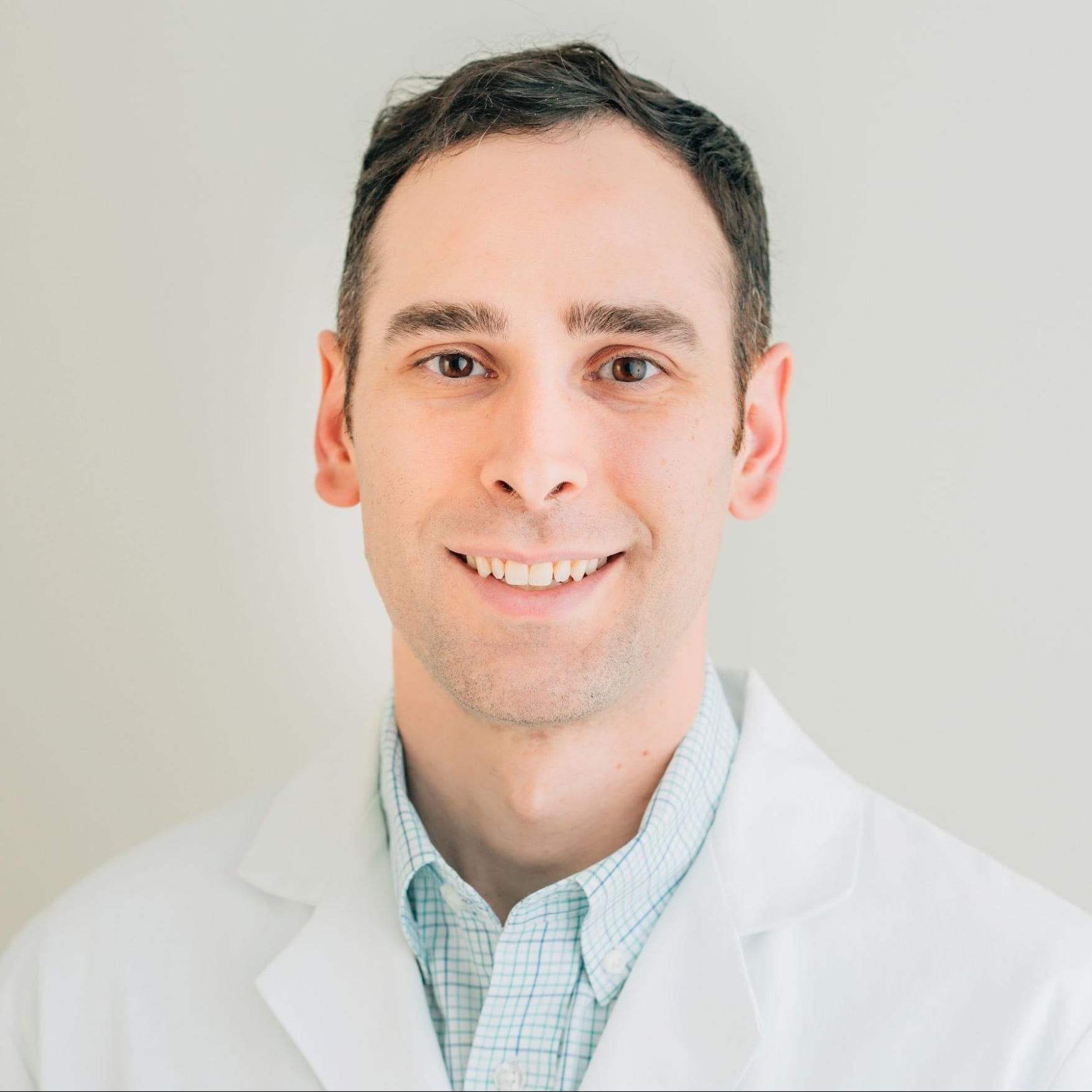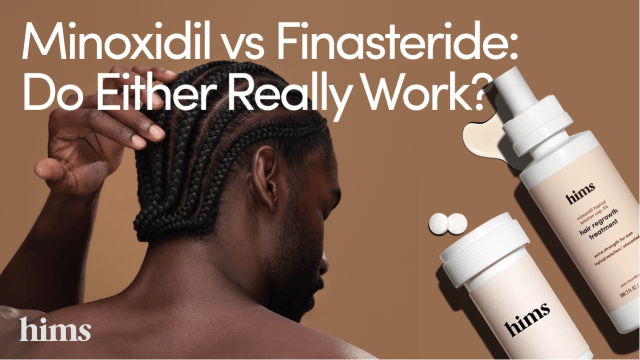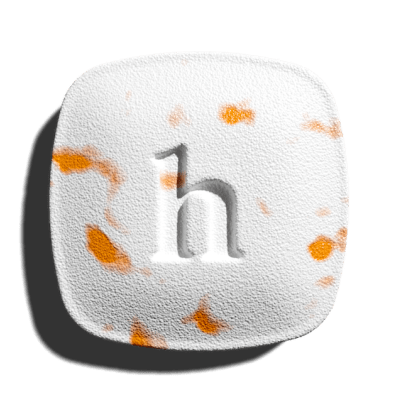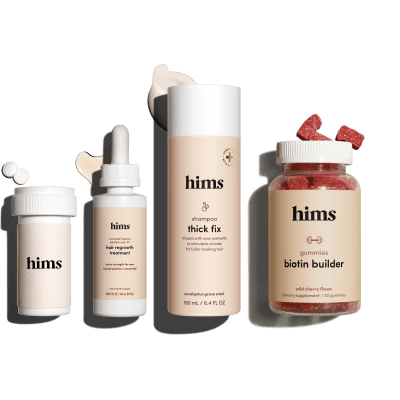Content
Over 90% of users saw increased regrowth or reduced hair loss in clinical trials
Finasteride & Minoxidil: The Most Effective Hair Loss Combo?

Out of all of the hair loss treatments out there, two options stand out among the rest: minoxidil and finasteride. But what’s the difference between the two? And is it possible to use both at the same time? Let’s look at finasteride vs minoxidil.
Although there are some key differences between minoxidil and finasteride, there’s no reason to pit them against each other — instead, when appropriate, you can use both. In fact, combining finasteride and minoxidil can be even more effective for hair loss than using one or the other.
Below, we’ll explain how finasteride and minoxidil work, review the research on both medications, and explore their potential side effects. We’ll also discuss how you can use these two hair loss treatments together to stop thinning hair and regrow a thicker, fuller mop.
Content

How Minoxidil and Finasteride Work
Dealing with hair loss is rough, especially if you’re one of the many men who experience male pattern baldness.
The good news is that you have a few treatment options. Minoxidil (the active ingredient in Rogaine®) and finasteride (the active ingredient in Propecia®) have both been around for decades, and plenty of research supports the claim that they can slow down male pattern hair loss.
The Food and Drug Administration has approved both oral finasteride and topical minoxidil for treating male androgenetic alopecia, also known as male pattern baldness or male pattern hair loss.
Although there is a topical version of finasteride and a pill form of minoxidil, the FDA hasn’t yet approved topical finasteride or oral minoxidil for treating hair loss. This doesn’t mean using these medications is illegal or dangerous, just that they haven't gone through the FDA’s rigorous approval processes.
Significant evidence supports both minoxidil and finasteride as effective treatments for hair loss. However, there are a few major differences in how these medications stop hair loss and promote hair growth.
Let’s look at how each works, which will help show the difference between minoxidil and finasteride.
How Minoxidil Works
Minoxidil was initially used in oral form to treat high blood pressure, but an unexpected side effect was soon discovered: hair growth.
Now, topical minoxidil is used as a hair loss treatment and is available as minoxidil foam and a liquid minoxidil solution. Both formulas are applied directly to the scalp.
Topical minoxidil is a vasodilator, which means it widens your blood vessels. It stimulates hair growth by boosting the circulation in your scalp, which promotes blood flow to your hair follicles — the tiny organs throughout your scalp from which individual hairs grow.
In addition to increasing blood flow, experts think minoxidil lengthens your hair growth cycle's anagen phase (the growth phase), allowing your hair to grow for a longer period before shedding.
It also shifts dormant hairs, such as those in the telogen (resting) phase, into the anagen phase to stimulate hair growth.
Minoxidil can also be used for other types of hair loss, including female pattern hair loss and stress-related hair loss.
You can think of minoxidil as a tool for stimulating hair growth and maintaining the hair you already have. While results vary from person to person, you can usually expect to see hair regrowth after eight weeks of treatment.
How Finasteride Works
Finasteride, also known by the brand name Propecia®, is another FDA-approved hair loss treatment. It stops your body from producing dihydrotestosterone (DHT), which causes male pattern baldness.
DHT is an androgen (male hormone) that’s essential in early life and adolescence when it plays a significant role in the development of genitals and secondary sex characteristics like facial and body hair.
But when you’re an adult, DHT can attach to receptors in your scalp and gradually cause hair follicles to miniaturize. Over time, this can impact your hair’s natural growth cycle and stop hairs from growing.
DHT normally affects hair follicles near the hairline and crown first. This results in the classic receding hairline that often develops in the early stages of male pattern baldness.
But why do some men develop male pattern baldness while others don’t? First, some men seem genetically predisposed to have higher DHT levels. Secondly, the androgen receptors in your scalp might be particularly sensitive to DHT.
The enzyme 5-alpha-reductase plays an important role in converting testosterone into DHT. Finasteride is a 5-alpha-reductase inhibitor, which means it reduces testosterone's conversion into DHT by blocking 5-alpha-reductase.
As a result, it can lower your DHT levels and prevent further hair loss.
Finasteride comes as an oral tablet prescribed in either 1-milligram (mg) or 5mg dosages, with the 1mg dose typically prescribed for hair loss.
To sum up, finasteride and minoxidil treat hair loss from different angles.
Minoxidil is a topical medication that works like a fertilizer, giving your hair the nutrients it needs to grow. Finasteride, on the other hand, is more like a shield that protects your hair follicles from damage caused by DHT hormones.
more hair... there's a pill for that
Clinical trials have shown that both medications are relatively safe and effective for hair loss. But like all prescription and over-the-counter drugs, there’s still a chance of experiencing finasteride and minoxidil side effects.
Although uncommon and relatively mild, the potential side effects of minoxidil include:
Skin irritation
Burning sensation
Dry, itchy skin
Exacerbation of seborrheic dermatitis
Excessive hair growth
Since minoxidil interrupts the hair growth cycle, it may cause you to shed slightly more hair during the first few months of use. This is usually temporary, and you should notice a higher hair count within a few more months.
The side effects of finasteride treatments can differ depending on whether you’re using oral finasteride or the topical solution.
The oral tablet can lead to sexual side effects that may affect your sexual function or enjoyment, like:
Erectile dysfunction (ED)
Changes in ejaculatory volume
Decreased libido
Topical finasteride side effects are uncommon, but a few have been reported, including:
Lightheadedness
Headaches
Testicular pain
In addition to side effects, finasteride can negatively interact with other medications, vitamins, or supplements.
While not considered serious side effects, these finasteride interactions may result in skin irritation, reduced libido, or allergic reactions.
When you speak with a healthcare professional about your hair loss treatment plan, it’s essential to be transparent about all the medications and supplements you take, whether prescription or over-the-counter. This helps them give you the best possible medical advice for your situation.
Now for the question you really want answered: How do minoxidil and finasteride results compare? Who’s the winner in the finasteride vs minoxidil showdown?
Drumroll, please! The answer is both.
One old 2004 comparative study found that oral finasteride was slightly more effective than minoxidil in treating androgenetic alopecia — but the authors point out that this difference was only slight.
It’s important to know that many studies have found that both are effective treatments.
First, let’s look at a review of the research on minoxidil:
A study looked at 904 men with androgenetic alopecia. After using a minoxidil 5% dosage twice a day for a year, 62 percent saw a significant decrease in hair loss.
Other studies found that both the 2% and 5% minoxidil concentrations improved hair density after 16 and 26 weeks, compared to a placebo.
After 48 weeks of treatment, 45 percent of 278 patients saw more hair growth using 5% minoxidil than the 2% concentration.
Meanwhile, finasteride results are comparable to minoxidil and just as noteworthy.
A study carried out in Japan looked at over 500 men with male pattern baldness. It found that more than 99 percent of participants didn’t experience any worsening of their hair loss during treatment with 1 mg of finasteride.
In the same study, 91.5 percent of the men experienced improvements in hair growth while using finasteride.
In another large Japanese study of over 3,000 men who used finasteride, over 36 percent experienced moderate hair regrowth, while 11 percent had significant hair growth over three years.
Topical finasteride was also found to significantly increase hair growth in over 300 men compared to a placebo. These results were similar to the DHT-blocking effects of oral finasteride.
Will you join thousands of happy customers?
4.5 average rating
Minoxidil and finasteride offer similar results, but what about using them together?
Research says a combined treatment is safe and may be more effective than one treatment alone. In fact, since finasteride and minoxidil work in different parts of the body, there's no risk in taking them together.
A study published in the Indian Dermatology Online Journal found that switching from oral finasteride to topical finasteride allowed patients to maintain good hair density when combined with ongoing use of topical minoxidil.
A review of several randomized controlled trials found that a combined oral finasteride and topical minoxidil treatment had better results and was just as safe as using either treatment alone.
A small 2012 double-blind study of 40 men compared topical minoxidil with a combination of topical finasteride and minoxidil. The group who took the combo seemed to have a greater reduction in hair loss, although there wasn’t a difference in new hair growth.
Doctors also agree that this combination is best.
“Finasteride and minoxidil work synergistically to help with hair growth,” says Dr. Knox Beasley, a board-certified dermatologist and a fellow of the American Academy of Dermatology. “I recommend using the combo to my patients whenever possible."
Now that you’re up to speed on all things finasteride and minoxidil, how do you choose which one to use?
Here’s what to keep in mind when weighing your options:
If you only have mild hair loss, you might want to start with minoxidil before trying other medications. As an over-the-counter drug, minoxidil is easy to add to your hair loss prevention routine without visiting a healthcare provider.
Finasteride and minoxidil are both safe to use, but side effects are always possible. If one causes uncomfortable side effects, the other might be a better option.
You might prefer minoxidil foam to the minoxidil solution. The foam dries faster and gets the medication to your hair follicles more quickly. However, some prefer using the solution — it’s all up to you.
If you want to try a combination treatment, consider this topical finasteride and minoxidil spray. As an easy-to-use, two-in-one product, it might even be the only hair loss treatment you need.
Or, if you don’t mind taking separate hair loss medications, you can try oral finasteride, which can be safely used with topical minoxidil.
Lastly, and perhaps the most important piece of advice we have to give:
Do. Not. Put. This. Off.
The longer you wait, the more hair you’ll lose. And the less likely it is that you’ll grow it back.
While it’s super important to consider your treatment plan options, don’t hem and haw for too long — get to a healthcare professional ASAP and get personalized medical advice.
You don’t need to have a minimum level of hair loss to use minoxidil or finasteride. However, you should have realistic expectations about what hair loss medications can do and understand that you may not be able to get all your hair back.
Hair loss treatments, delivered
Although weighing the merits of minoxidil vs. finasteride is tempting, both hair-loss medications are incredibly effective and can even be used together.
We’d like to reimagine the duo as partners, not competitors — a match made in hair growth heaven.
Here’s what you need to know:
Minoxidil is an over-the-counter, topical medication. It works by increasing blood flow to the scalp and shifting hair follicles into the growth phase of the hair growth cycle.
Finasteride is a prescription treatment. It’s available as a topical or oral medication. Both work by protecting your hair follicles from DHT, a hormone that damages your hair follicles and causes male pattern baldness.
They’re effective — especially when used together. The combination of finasteride and minoxidil is safe and can help you restore some of the hair you’ve lost, as well as keep you from losing more.
Whether you choose finasteride, minoxidil, or a combination of the two, time is of the essence. Delaying your treatment can lead to further hair loss.
We can help you book an online consultation with a healthcare professional, which means you can get medical advice on hair loss from the comfort of your own home. Together, you can assess your hair loss and figure out a suitable treatment plan.
16 Sources
- Asfour L, et al. (2023). Male Androgenetic Alopecia. Available from https://www.ncbi.nlm.nih.gov/books/NBK278957/
- Chandrashekar BS, et al. (2015). Topical minoxidil fortified with finasteride: An account of maintenance of hair density after replacing oral finasteride. Available from https://www.ncbi.nlm.nih.gov/pmc/articles/PMC4314881/
- Chen L, et al. (2020). The Efficacy and Safety of Finasteride Combined with Topical Minoxidil for Androgenetic Alopecia: A Systematic Review and Meta-analysis. Available from https://cdn.mednet.co.il/2012/05/the-efficacy-and-safety-of-finasterideminoxidil.pdf
- Gupta AK, et al. (2022). Relative Efficacy of Minoxidil and the 5-α Reductase Inhibitors in Androgenetic Alopecia Treatment of Male Patients: A Network Meta-analysis. https://jamanetwork.com/journals/jamadermatology/fullarticle/2788258
- Ho CH, et al. (2024). Androgenetic Alopecia. Available from https://www.ncbi.nlm.nih.gov/books/NBK430924/
- Kinter KJ, et al. (2024). Biochemistry, Dihydrotestosterone. Available from https://www.ncbi.nlm.nih.gov/books/NBK557634/
- Lee SW, et al. (2018). A Systematic Review of Topical Finasteride in the Treatment of Androgenetic Alopecia in Men and Women. Available from: https://www.ncbi.nlm.nih.gov/pmc/articles/PMC6609098/
- Piraccini BM, et al. (2022). Efficacy and safety of topical finasteride spray solution for male androgenetic alopecia: a phase III, randomized, controlled clinical trial. Available from https://www.ncbi.nlm.nih.gov/pmc/articles/PMC9297965/
- PROPECIA® (finasteride) tablets for oral use. (n.d.). Accessdata.fda.gov. Available from https://www.accessdata.fda.gov/drugsatfda_docs/label/2014/020788s024lbl.pdf
- Nestor MS, et al. (2021). Treatment options for androgenetic alopecia: Efficacy, side effects, compliance, financial considerations, and ethics. Available from https://onlinelibrary.wiley.com/doi/pdf/10.1111/jocd.14537
- Tanglertsampan C. (2012). Efficacy and safety of 3% minoxidil versus combined 3% minoxidil / 0.1% finasteride in male pattern hair loss: a randomized, double-blind, comparative study. Available from https://pubmed.ncbi.nlm.nih.gov/23193746/
- Patel P, et al. (2024). Minoxidil. Available from https://www.ncbi.nlm.nih.gov/books/NBK482378/
- Suchonwanit P, et al. (2019). Minoxidil and its use in hair disorders: a review. Available from: https://www.ncbi.nlm.nih.gov/pmc/articles/PMC6691938/
- Tanglertsampan C. (2012). Efficacy and safety of 3% minoxidil versus combined 3% minoxidil / 0.1% finasteride in male pattern hair loss: a randomized, double-blind, comparative study. Available from https://pubmed.ncbi.nlm.nih.gov/23193746/
- Yanagisawa M, et al. (2019). Long-term (10-year) efficacy of finasteride in 523 Japanese men with androgenetic alopecia. 5. Available from https://www.researchgate.net/publication/337105943_Long-term_10-year_efficacy_of_finasteride_in_523_Japanese_men_with_androgenetic_alopecia
- Zito PM, et al. (2024). Finasteride. Available from https://www.ncbi.nlm.nih.gov/books/NBK513329/
Editorial Standards
Hims & Hers has strict sourcing guidelines to ensure our content is accurate and current. We rely on peer-reviewed studies, academic research institutions, and medical associations. We strive to use primary sources and refrain from using tertiary references. See a mistake? Let us know at blog@forhims.com!
This article is for informational purposes only and does not constitute medical advice. The information contained herein is not a substitute for and should never be relied upon for professional medical advice. Always talk to your doctor about the risks and benefits of any treatment. Learn more about our editorial standards here.
Knox Beasley, MD
Dr. Knox Beasley is a board certified dermatologist specializing in hair loss. He completed his undergraduate studies at the United States Military Academy at West Point, NY, and subsequently attended medical school at Tulane University School of Medicine in New Orleans, LA.
Dr. Beasley first began doing telemedicine during his dermatology residency in 2013 with the military, helping to diagnose dermatologic conditions in soldiers all over the world.
Dr. Beasley is board certified by the American Board of Dermatology, and is a Fellow of the American Academy of Dermatology.
Originally from Nashville, TN, Dr. Beasley currently lives in North Carolina and enjoys spending time outdoors (with sunscreen of course) with his wife and two children in his spare time.
Education
Bachelor of Science, Life Sciences. United States Military Academy.
Doctor of Medicine. Tulane University School of Medicine
Training
Dermatology Residency. San Antonio Uniformed Services Health Education Consortium
Certifications
Board Certified. American Board of Dermatology
Publications
Wilson, L. M., Beasley, K. J., Sorrells, T. C., & Johnson, V. V. (2017). Congenital neurocristic cutaneous hamartoma with poliosis: A case report. Journal of cutaneous pathology, 44(11), 974–977. https://onlinelibrary.wiley.com/doi/10.1111/cup.13027
Banta, J., Beasley, K., Kobayashi, T., & Rohena, L. (2016). Encephalocraniocutaneous lipomatosis (Haberland syndrome): A mild case with bilateral cutaneous and ocular involvement. JAAD case reports, 2(2), 150–152. https://www.ncbi.nlm.nih.gov/pmc/articles/PMC4867906/
Patterson, A. T., Beasley, K. J., & Kobayashi, T. T. (2016). Fibroelastolytic papulosis: histopathologic confirmation of disease spectrum variants in a single case. Journal of cutaneous pathology, 43(2), 142–147. https://onlinelibrary.wiley.com/doi/10.1111/cup.12569
Beasley, K., Panach, K., & Dominguez, A. R. (2016). Disseminated Candida tropicalis presenting with Ecthyma-Gangrenosum-like Lesions. Dermatology online journal, 22(1), 13030/qt7vg4n68j. https://pubmed.ncbi.nlm.nih.gov/26990472/
Kimes, K., Beasley, K., & Dalton, S. R. (2015). Eruptive milia and comedones during treatment with dovitinib. Dermatology online journal, 21(9), 13030/qt8kw141mb. https://pubmed.ncbi.nlm.nih.gov/26437285/
Miladi, A., Thomas, B. C., Beasley, K., & Meyerle, J. (2015). Angioimmunoblastic t-cell lymphoma presenting as purpura fulminans. Cutis, 95(2), 113–115. https://pubmed.ncbi.nlm.nih.gov/25750965/
Beasley K, Dai JM, Brown P, Lenz B, Hivnor CM. (2013). Ablative Fractional Versus Nonablative Fractional Lasers – Where Are We and How Do We Compare Differing Products?. Curr Dermatol Rep, 2, 135–143. https://idp.springer.com/authorize?response_type=cookie&client_id=springerlink&redirect_uri=https%3A%2F%2Flink.springer.com%2Farticle%2F10.1007%2Fs13671-013-0043-0
Siami P, Beasley K, Woolen S, Zahn J. (2012). A retrospective study evaluating the efficacy and tolerability of intra-abdominal once-yearly histrelin acetate subcutaneous implant in patients with advanced prostate cancer. UroToday Int J, June 5(3), art 26. https://www.urotoday.com/volume-5-2012/vol-5-issue-3/51132-a-retrospective-study-evaluating-the-efficacy-and-tolerability-of-intra-abdominal-once-yearly-histrelin-acetate-subcutaneous-implants-in-patients-with-advanced-prostate-cancer.html
Siami P, Beasley K. (2012). Dutasteride with As-Needed Tamsulosin in Men at Risk of Benign Prostate Hypertrophy Progression. UroToday Int J, Feb 5(1), art 93. https://www.urotoday.com/volume-5-2012/vol-5-issue-1/48691-dutasteride-with-as-needed-tamsulosin-in-men-at-risk-of-benign-prostatic-hypertrophy-progression.html





